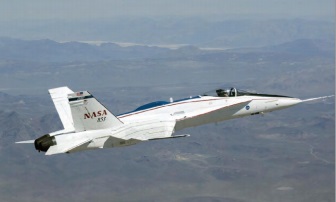Chapter: Engineering Successes, new invention technology, Research project papers,
Flying an Airplane Like a Rocket

Flying an Airplane Like a Rocket
NASA Armstrong's high-performance F/A-18 Full-Scale Advanced
Systems Testbed (FAST) aircraft was key to helping test and validate the
effectiveness of innovative self-adaptive software being considered for use in
the next-generation Space Launch System (SLS). Developed by engineers at
Marshall Space Flight Center, the SLS rocket will be NASA's largest and most
powerful launch vehicle for deep space missions. The adaptive software is
designed to make real-time adjustments as a vehicle pushes toward space,
helping to improve rocket performance and enhance crew safety in the
particularly stressful launch portions of flight. The team installed SLS flight
control software onto research computers aboard the FAST aircraft and simulated
a rocket in its early flight phase to test the adaptive control software. The
FAST aircraft's high performance allowed
it to fly a trajectory
that was dynamically similar to a rocket launch. This collaborative project
yielded a major advance in launch vehicle flight control technology and
substantially accelerated the application of adaptive control to manned
systems.
Work to date: Flight tests occurred
at Armstrong in late 2013. During these flights, almost 100 SLS
trajectories and over a dozen straight-and-level airframe structural
amplification tests were successfully executed, many of which focused on
collecting additional data regarding the interaction of the pilot, the
simulated SLS vehicle dynamics, and the adaptive augmenting control algorithm.
Looking ahead: The team is analyzing
flight data and considering ways to apply similar technology to
aircraft and atmospheric re-entry vehicles.
NASA Partners: Marshall Space Flight
Center and NASA Engineering and Safety Center
' The goal of the F/A-18 flights was to
advance the technology readiness of the SLS adaptive control design by
operating it in a relevant environment while intro-ducing a wide variety of
unusual launch scenarios. Test pilots also exercised the SLS controller's
manual steering mode,
providing valuable feedback on its design and performance. '
Curtis Hanson, PI
Engineering Successes
Armstrong's Research and Engineering Directorate is responsible
for the overall engineering content of flight research projects. Our engineers
provide technical expertise in aerodynamics; guidance, navigation, and control;
propulsion; static and dynamic structures; flight hardware and software; flight
and ground test instrumentation and data systems; and system engineering and
integration. They apply their expertise across the spectrum of Armstrong's many
activities and also support the development and continual evolution of
engineering tools and test techniques. Here are highlights from a few recent
and particularly notable engineering success stories.
Related Topics